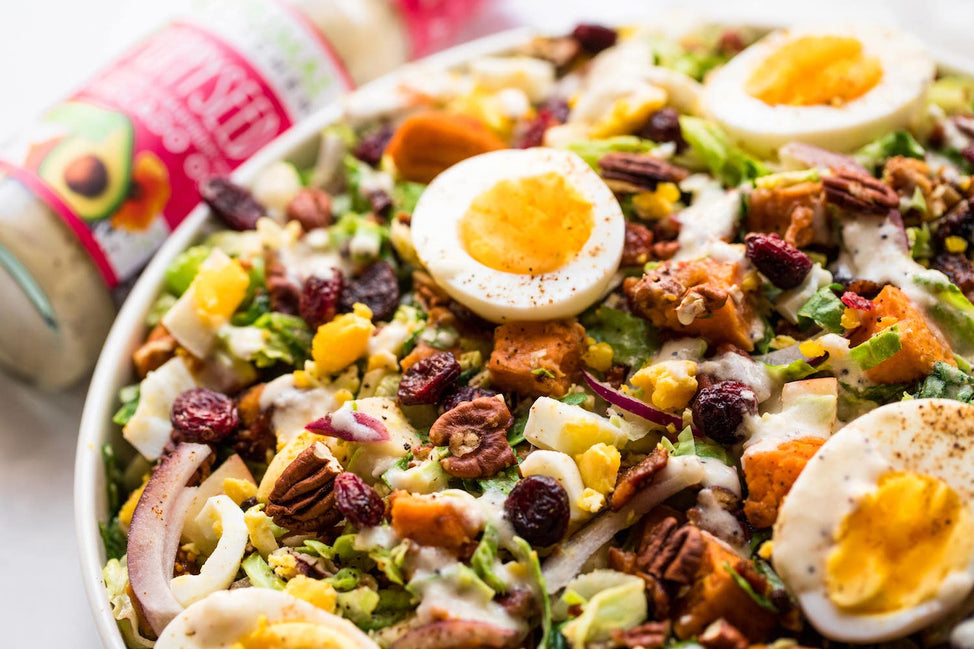Savvy shoppers and cooks recognize that all oils aren’t created equal, but sorting out the facts about different types of oils can be confusing. Here’s where to start.
What Are Seed Oils?

As the name implies, seed oils are derived from the seed of a plant. When you hear people talk about “seed oils,” though, they’re usually referring specifically to oils that are also known as “industrial seed oils” because of the chemicals like hexane and solvents involved in turning the raw seeds into the bottled oil you find at the store. These are:
- Canola oil
- Corn oil
- Cottonseed oil
- Grapeseed oil
- Rice bran oil
- Soy oil
- Sunflower oil
- Safflower oil
The generically named “vegetable oil” on supermarket shelves is usually a mix of several seed oils, such as canola, corn, soybean, and/or sunflower oils.
Industrial seed oils only became widespread in the food system in the last century. Today, they’re hard to avoid. Because industrial seed oils are generally cheap and shelf-stable, food manufacturers often use seed oils to make so-called ultra-processed foods, and restaurants fill their deep fryers with the stuff. Consumption of ultra-processed foods in the U.S. has increased over the last two decades,1 so it's no surprise that the average person's seed oil consumption has also risen dramatically in recent decades.2,3
So what’s the problem? Seed oils like soybean, sunflower, corn, and cottonseed are predominantly polyunsaturated fat, much of which is linoleic acid, an omega-6 fatty acid. We need omega-6s in our diets, but some health experts have become concerned about the increase in omega-6 fatty acid intake in recent decades and whether a diet that contains too much omega-6 and too little omega-3 and monounsaturated fat is suboptimal.4,5,6,7,8
While maintaining the right balance of omega-6 and omega-3 fatty acids in the diet is important, it's essential to keep the bigger picture in mind. Since seed oils are in many ultra-processed foods, reducing your intake of one will generally reduce your intake of the other. As registered dietitian Brynn Medlock, RD, explains, “Many people are making an effort to eat more nutrient-dense, whole foods like meat, vegetables, dairy, whole grains, and fruit while reducing their intake of ultra-processed foods and, consequently, seed oils. This shift reflects a growing desire to return to the basics, and we see consumers leaning on their own intuition about what’s best for themselves and their families—a movement that has sparked a positive trend toward real, wholesome food.”
How Does Avocado Oil Compare to Seed Oils?
First and foremost, avocado oil is NOT a seed oil. Avocado oil is derived from the whole fruit. (The same goes for olive oil, by the way.)
One reason that canola oil, peanut oil, and other seed oils are so popular with food manufacturers is that thanks to how they are processed, they have a relatively neutral taste and a high smoke point. But guess what? Avocado oil also has a neutral flavor that makes it perfect for all sorts of cooking applications, with a smoke point on par with or higher than common seed oils!
Avocado oil is also prized for its monounsaturated fat content. That’s why we like to call avocado oil a source of good fats we love. Approximately 70% of the fatty acids in avocado oil are of the much-lauded monounsaturated type with around 17% polyunsaturated, similar to olive oil.9

What Are Some Other Alternatives to Seed Oils?
If you’re looking to cut down on your consumption of seed oils, here are a couple of tips:
- Since seed oils are found widely in packaged and processed foods, the more you switch to real, whole food ingredients, the less you’ll encounter seed oils.
- Embrace avocado oil and olive oil in your home cooking. Olive oil has a similar fat content and nutritional profile to avocado oil.
You might want to explore other oils, as well:
-
If you avoid seed oils due to the linoleic acid content, you might feel more comfortable with high-oleic varieties. High-oleic oils come from seeds that are specially bred for their fatty acid profiles. For example, compared to regular sunflower oil, high-oleic sunflower oil contains less linoleic acid (a polyunsaturated fat) and more monounsaturated fat—making it more similar to avocado oil.
- Coconut oil and animal fats like tallow and lard are popular in the Primal Blueprint community, but note that they are comparatively high in saturated fats. (Fun fact: that’s why they’re solid at room temperature.) Some seed-oil-free products use these oils instead.
Avocado Oil + Real Food: A Match Made in Heaven
Primal Kitchen products are proudly made with real food ingredients because we believe that what we eat matters. Our products are intentionally crafted with premium ingredients like pure avocado oil, organic California-grown tomatoes, and sweeteners from natural sources to make all your meals and snacks more delicious.
Here at Primal Kitchen, avocado oil is the star of the show. With its neutral flavor and good fats, we think there’s nothing that avocado oil can’t do!
Real Love for Primal Kitchen Avocado Oil Products
Primal Kitchen makes the best avocado oil and top-rated avocado oil mayo and dressings. But don’t just take our word for it!
- Organic Authority rates Primal Kitchen dressings made with avocado oil among their favorites.
- Eat This Not That tapped their network of Registered Dietitians to hear what salad dressings they’d recommend. (Spoiler: Primal Kitchen made the cut!)
- Eat This Not That also shared a list of dietician-approved salad dressings.


